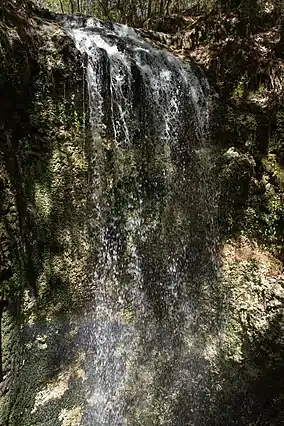| Falling Waters State Park | |
|---|---|
 Falling Waters | |
 Location of Falling Waters State Park in Florida  Falling Waters State Park (the United States) | |
| Location | Washington County, Florida, United States |
| Nearest city | Chipley, Florida |
| Coordinates | 30°43′41″N 85°31′43″W / 30.72806°N 85.52861°W |
| Area | 171 acres (69 ha) |
| Elevation | 239 ft (73 m)[1] |
| Established | 1962 |
| Named for | Falling Water Falls |
| Visitors | 30000 (in in 2008)[2] |
| Governing body | Florida Division of Recreation and Parks |
| Website | Falling Waters State Park |
Falling Waters State Park is a 171-acre (69 ha) Florida state park located three miles (5 km) south of Chipley, Washington County in northwestern Florida. The park contains a 73-foot (22 m) waterfall, the highest in the state [3] known as "Falling Waters Falls”.
History
The sinkholes at Falling Waters State Park were used as a hideout by Indian warriors fighting against Andrew Jackson during the Seminole Wars.[4] The park is the site of a Civil War era gristmill.[5] The gristmill was powered by the waterfall in Falling Waters Sink. Later, in 1891, a distillery was constructed on the site.[5] The park is also the site of the first oil well in Florida. It was drilled in 1919 based on information from local legends and a 400-year-old Spanish diary. The well, which reached a depth of 4,912 feet (1,497 m) never proved to hold a commercially viable amount of oil and was capped in 1921.[5]
The park was deeded to the state in 1962 by the Washington County Development authority.[6] Park facilities such as a picnic pavilion and restrooms were constructed soon after.[7] An archaeologic dig, led by the University of West Florida in 2007, revealed Indian artifacts that were between 1,000 and 1,500 years old.[8] Items found included bits of pottery, Indian arrowheads and what may be the only cave painting in Florida.[8] The archaeologists noted that they thought the same thing that attracts visitors to the park today, the waterfall, also attracted Native Americans to the site.[8] Remnants of the gristmill, distillery and oil well were also found by the team from the university.[8]
Geology
Extended systems of underwater caves, sinkholes and springs are found throughout Florida. The limestone is topped with sandy soils deposited as ancient beaches over millions of years as global sea levels rose and fell. During the last glacial period, lower sea levels and a drier climate revealed a much wider peninsula, largely savanna.[9]
Falling Waters State Park lies atop a bed of limestone that has been eroded over the years by water which has created the sinkholes and caverns that are found throughout the park.[10] The waterfalls of Falling Waters State Park fall into a 100-foot (30 m) sinkhole known as Falling Waters Sink.[3] The waterfalls are fed by springs that are dependent on rainfall.[11] The water from the falls disappears into a large cavern at the base of the sinkhole. The sinkhole can be accessed by visitors by way of a paved trail and boardwalk.[10]
Recreation
Falling Water State Park is open for year-round recreation including camping, fishing, hiking and swimming.[12] The park is noted for hosting campfire circles. Park rangers give interpretive talks at the circles and present a slide show. The main campground is on one of the highest hills in Florida at 324 feet (99 m).[12] It has twenty-four sites that are equipped with electricity, fresh water, picnic tables and grills and a clothesline. Swimming and fishing are permitted in the 2 acres (0.81 ha) lake.
Gallery

 View down into the sink
View down into the sink
References
- ↑ "Falling Waters State Park". Geographic Names Information System. United States Geological Survey. August 28, 1987. Retrieved June 22, 2010.
- ↑ Felsberg, Jay (February 5, 2008). "Falling Waters volunteers honored". Washington County News. Archived from the original on July 8, 2011. Retrieved June 22, 2010.
- 1 2 "Welcome to Falling Waters State Park". Florida Division of Recreation and Parks. Archived from the original on May 24, 2010. Retrieved June 22, 2010.
- ↑ Gallagher, Peter B. (February 13, 1985). "What next for a waterfall? What next for a state?". St. Petersburg Times. p. 10-D. Retrieved June 22, 2010.
- 1 2 3 "Falling Waters State Park: History". Florida Division of Recreation and Parks. Retrieved June 22, 2010.
- ↑ "Florida news briefs". Daytona Beach Morning Journal. April 13, 1962. p. 6. Retrieved June 22, 2010.
- ↑ "New University Gets First Official". Daytona Beach Morning Journal. July 25, 1962. p. 5. Retrieved June 22, 2010.
- 1 2 3 4 Morrison, Jeremy (December 23, 2007). "Archaeologists Dig in the Panhandle". The Panama City News-Herald. p. B-5. Retrieved June 22, 2010.
- ↑ Allen, Ginger M.; Main, Martin B (May 2005). "Florida's Geological History". Florida Cooperative Extension Service. University of Florida. Retrieved June 23, 2010.
- 1 2 "Falling Waters State Park". Dale Cox. Retrieved June 22, 2010.
- ↑ "About Falling Waters State Park". Florida Division of Recreation and Parks. Archived from the original on May 1, 2010. Retrieved June 22, 2010.
- 1 2 "Activities at Falling Waters State Park". Florida Division of Recreation and Parks. Retrieved June 22, 2010.
External links
![]() Media related to Falling Waters State Park at Wikimedia Commons
Media related to Falling Waters State Park at Wikimedia Commons